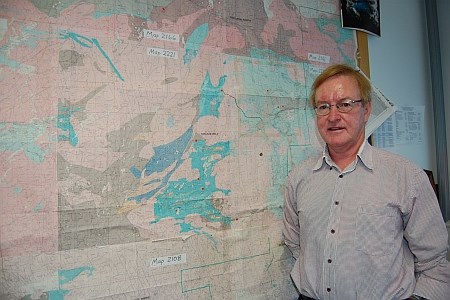With the price of gold continuing to hit record heights, the Timmins camp is becoming a hotbed of renewed activity unseen since before the recession as juniors and producers alike seek to strike it rich.
While the numbers surrounding the value of exploration in the region are unavailable, more than 90 companies are currently digging up and around the Timmins geological district.
“There’s so much happening, it’s incredible,” says Brian Atkinson, Ontario Geological Survey regional resident geologist for the Timmins region.
“The companies can raise money on the world market for gold projects, and investors like Timmins. When the people that raise the funds go to Europe, they hear that again and again, and that’s why they’re able to get all those dollars for exploration here and why there’s a lot of emphasis on the region right now.”
This includes smaller up-and-comers such as Trelawney Mining and Exploration, one of the juniors seemingly on the tip of everyone’s tongue as it seeks to bring the Chester Property into production 121 kilometres southwest of Timmins. Similar attention is being paid to Canadian Arrow’s recent efforts to bring its Alexo and Kelex properties, 50 kilometres east of Timmins, back into production.
Also digging away is VG Gold, which is working towards an initial resource estimate for its Paymaster West Project, just 2,500 feet from the edge of Goldcorp’s Dome Mine and mill. The company is looking to establish the open-pit potential of the past-producing property.
These are just a few of the many junior firms working to find their claim to fame, while a series of current and potential producers sit on the cusp of bringing more gold out of the ground.
The explosion of exploration and production activity in the area is generating considerable optimism from some of the region’s mining industry figures, who say the boom is creating a strong run on skilled staff.
“I have a geologist friend who’s 72, and he’s working on a consulting basis,” says Robert Calhoun, who spearheads the Timmins Economic Development Corporation’s Discover Abitibi, a geophysical mapping initiative. “It’s not quite back to 2006 and 2007, where if I didn’t like the way you looked at me today, I’d go work for someone else tomorrow. It’s not that good, but it’s getting there.”
Much of this interest is being driven by higher metal prices not only in gold but also in base metals, as nickel and copper continue to offer “favourable” opportunities even in smaller and otherwise uneconomic deposits, says Atkinson. Given the temperamental and heavily cyclical nature of the industry, however, there is a strong and imminent need to bring those deposits into production as rapidly as possible.
“With a smaller deposit, you have a five-year threshold sort of thing, and you have to be sure you can get your investment paid off and make money doing it in that short time period,” says Atkinson. “It’s more of a challenge, and that’s why there is that urgency to get the deposits up and running and the mine completed while the prices of the metals are favourable.”
However, while the rapid development of projects such as Detour Gold’s three-year jump from property acquisition to mine development is hailed by some, not everyone is pleased.
“That might be the biggest difference between some of yourselves and us,” says Mushkegowuk Council Grand Chief Stan Louttit. “You like to jump into it and say okay, let’s get going and have a mine in a few years’ time. Us, we’re a bit different; we’re saying, ‘Let’s take it a little bit slow, let’s take a look at those rivers and the environment.’ It’s a little bit different where we are because our people use those areas.”
As the Mushkegowuk Council represents a population of 10,000 First Nation people along the James Bay coast as well as near Cochrane, Chapleau and Garden River, many of the region’s mining projects represent opportunities for economic development, says Louttit.
However, they also represent challenges, he says, as government wishes to dictate what happens in the First Nations’ territories rather than accommodating them. Efforts for initial consultation is becoming more frequent and is a good first step, but more needs to be done, particularly in light of the poverty- evel living conditions experienced by many First Nations in resource-rich areas, he says.
What his member communities want is no different than what a city like Timmins would ask for, he adds.
“When government and resource developerswant to come to your municipality and your doorstep, you want to be able to say yes or no,” says Louttit. “You want to be able to say, ‘Yeah, this is good, but don’t we have a say?’ In our context, that’s what we’re saying too, as we want to be able to say yes, and if it’s just not right at that moment, we want to be able to say, ‘No, not right now.’”




